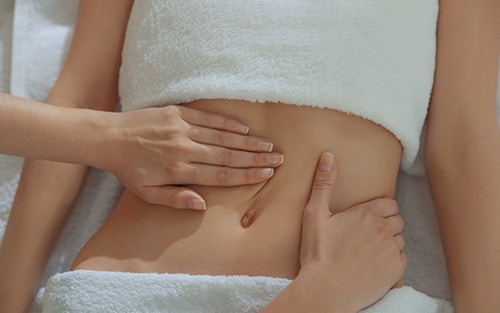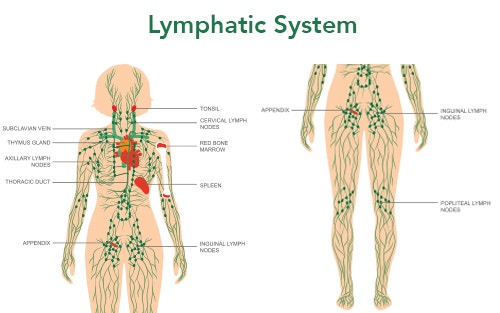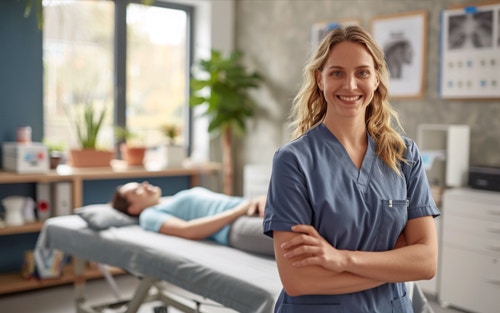Are you wondering how lymphatic massage can benefit you? This article will provide the necessary information to help you decide if this massage is suitable for you. It will reveal how this gentle treatment can support your lymphatic system, a crucial part of your immune health, as well as cover practical techniques, tangible benefits, and necessary safety tips without overstepping medical advice.

Key Takeaways
- Lymphatic massage is a gentle therapy designed to improve lymph flow, boost immune function, and manage lymphedema. It can be beneficial for individuals under 60.
- Various techniques such as Manual Lymphatic Drainage (MLD), Simple Lymphatic Drainage (SLD), and the Vodder Technique are used to stimulate lymph movement.
- Alongside health benefits, lymphatic massages contribute to skincare and cellulite reduction, and precautions should be taken by consulting healthcare providers before starting therapy due to potential contraindications.
Understanding Lymphatic Massage
Lymphatic massage is a specialized form of therapy that utilizes light, soothing strokes to encourage the movement of lymph fluids throughout the body. This type of massage is not only a maintenance technique that ensures conditions like lymphedema do not worsen with regular application but is also highly beneficial for individuals younger than 60.
With a duration of at least 20 minutes per session, lymphatic massage stands out as a unique and nurturing experience that supports your body’s innate healing mechanisms.
The Basics of the Lymphatic System
The lymphatic system, intricately woven into the fabric of our immune defenses, maintains fluid balance and protects against invaders. Picture lymphatic fluid flowing through a network of lymph vessels, leading to lymph nodes that act as biological checkpoints where white blood cells eliminate harmful substances.

Engaging in lymphatic massages can increase this vital circulation, enhancing your body’s ability to transport these protective cells and bolstering immune function.
Principles of Lymphatic Drainage
Hydration emerges as a key player in the realm of lymphatic drainage. Lymph, being 96% water, relies on a well-hydrated system to flow smoothly, making water intake essential for the health of your lymphatic system. By keeping hydrated, you ensure that this crucial fluid can carry out its role effectively, supporting your body’s natural detoxification processes.
Lymphatic Massage vs. Deep Tissue Massage
While lymphatic massage employs gentle pressure, akin to the weight of a teaspoon, to promote lymph flow, deep tissue massage dives deeper, targeting tense muscles and connective tissues. The feather-light touch of lymphatic massage is designed to detoxify the body and reduce puffiness, unlike deep tissue massage, which seeks to alleviate muscle tightness and chronic pain.
You may feel a sense of lightness after lymphatic massage, while deep tissue may result in muscle soreness, yet both offer unique pathways to well-being.
Essential Techniques for Effective Lymphatic Drainage Massage
Various specialized techniques have been developed to achieve the full benefits of lymphatic drainage. Manual Lymphatic Drainage (MLD) and Simple Lymphatic Drainage (SLD), along with the renowned Vodder Technique, are all designed to stimulate the movement of lymph fluids and prevent the uncomfortable accumulation of fluid within the body.
Manual Lymphatic Drainage (MLD)
Manual Lymphatic Drainage (MLD), also known as manual lymph drainage, is a cornerstone technique performed by therapists trained to apply light, strategic strokes that reroute stagnant lymphatic fluid and alleviate swelling in affected limbs. Unlike more robust massage forms, MLD’s gentle pressure and specific sequence, starting with unaffected nodes to establish drainage pathways, make it a specialized and therapeutic approach.
Simple Lymphatic Drainage (SLD)
For those seeking a self-care approach to drain my lymphatic system, Simple Lymphatic Drainage (SLD) empowers individuals to perform gentle massage on themselves, promoting fluid balance and supporting immune function. With careful, light movements, SLD can be practiced from the comfort of your home, following a sequence from the neck to the underarms and knees, directing flow towards the heart.
Vodder Technique
The Vodder Technique, a brainchild of Emil Vodder, enhances Manual Lymphatic Drainage through specific hand movements such as ‘thumb circle,’ ‘stationary circle,’ and ‘pump,’ meticulously adapted to treat areas with edema and fibrosis.
The Health Benefits of Regular Lymphatic Massages
Embracing lymphatic drainage massages regularly can yield a treasure trove of health benefits, including:
- Improved circulation
- Reduced swelling
- Enhanced skin tone
- Management of lymphedema
These massages, performed by a skilled massage therapist, are a gateway to better health and vitality.

Boosting Immune Function
Regular lymphatic massages can potentially turn your body into a fortress against illness. Massages distribute essential nutrients and remove waste by boosting lymph circulation and fortifying your immune system. Research even suggests that massages can increase the number of lymphocytes, which are vital for immune defense.
Managing Lymphedema and Chronic Venous Insufficiency
Lymphatic massages shine as a beacon of hope for those struggling with lymphedema and chronic venous insufficiency. By encouraging lymph flow, these massages:
- Reduce swelling
- Manage symptoms
- Offer relief
- Improve the quality of life
Enhancing Skin Care and Reducing Cellulite
Beyond health, lymphatic massages can be your ally in skincare and cellulite reduction. By assisting in the breakdown of fat cells and promoting even skin texture, these massages can contribute to a more toned and youthful appearance.
At-Home Lymphatic Massage: A Step-by-Step Guide
At-home lymphatic massage is a ritual that combines gentle strokes with deep breathing to encourage lymph flow and overall health. Whether you want to manage lymphedema or simply maintain your lymphatic system, this guide will show you how.
Preparing Your Space and Body
Setting up a calming environment and preparing your body are the first steps toward a successful at-home lymphatic massage.
For optimal results, start at the neck and move to your armpits and abdomen, using soft, rhythmic movements.
Self-Massage Techniques
SLD self-massage techniques can be easily integrated into your daily routine. Here are some areas you can focus on:
- Neck
- Arms
- Chest
- Legs
Gentle strokes on these areas stimulate lymph flow and support your body’s detoxification process.
Incorporating Deep Breathing Exercises
When paired with self-massage, deep breathing exercises can significantly enhance lymphatic drainage. They prepare the body for therapy, stimulate lymph flow, and contribute to a more effective massage by utilizing lymphatic drainage massage techniques.
When to Seek Professional Lymphatic Massage Therapy

There are instances where the expertise of a certified lymphedema therapist is necessary. Professional lymphatic massage therapy is recommended for post-surgical recovery, breast cancer-related lymphedema, and as part of comprehensive decongestive therapy.
Post-Surgical Recovery
Lymphatic massage can play a pivotal role in your post-surgical recovery, aiding in the reduction of swelling and speeding up the healing process.
Breast Cancer-Related Lymphedema
For breast cancer survivors, lymphatic massage offers a ray of hope in managing lymphedema. It can alleviate swelling and discomfort, significantly reducing lymphedema with proper intervention.
Comprehensive Decongestive Therapy
Comprehensive Decongestive Therapy includes the following modalities to offer a robust solution for managing lymphedema:
- Lymphatic massage
- Compression therapy
- Exercise
- Skincare
This therapy ensures sustained benefits and prevents fluid reaccumulation.
Precautions and Contraindications
Before engaging in lymphatic massage, it’s vital to be aware of contraindications and consult a healthcare provider to avoid risks and ensure a safe and beneficial experience.
Understanding Risks
Understanding the risks is crucial, as lymphatic massage can trigger adverse reactions in individuals with certain health conditions, such as thyroid dysfunction or active bleeding.
Consulting Healthcare Providers
Always consult with healthcare providers before starting lymphatic massage therapy. They can provide personalized advice and ensure the treatment suits your specific health needs.
Optimizing Lymphatic Health Beyond Massage

Lymphatic health goes beyond massage. Proper hydration, diet, and physical activity, along with the use of compression garments, play a key role in maintaining a healthy lymphatic system.
Hydration and Diet
Good hydration and a nutritionally balanced diet are essential for supporting the health of your lymphatic system. Start your day with water and include plenty of hydrating foods in your diet.
Physical Activity
Physical activity is a natural ally of the lymphatic system. Regular exercise encourages lymph movement and can help reduce swelling in individuals with lymphedema.
Use of Compression Garments
Compression garments are a valuable addition to lymphatic massages. They help reduce swelling and promote proper lymphatic and blood flow, which is essential for controlling lymphedema.
Lymphatic Summary
Throughout this journey, you’ve discovered the gentle power of lymphatic massage in enhancing physical and mental well-being. Whether through professional therapy or at-home techniques, maintaining lymphatic health is within reach. Embrace the practice, and let your body’s natural cleansing system work its magic for a healthier, more vibrant you.
Lymphatic Massage Frequently Asked Questions
These are the most common lymphatic massage questions we get at yourfootpalace.com:
What exactly does lymphatic massage do?
Lymphatic massage helps detoxify, boosts immune function, reduces swelling, and improves skin health by gently stimulating the movement of lymph fluids. It is beneficial for overall wellness and relaxation.
How often should I have a lymphatic massage?
You should have a lymphatic massage session for maintenance at least 20 minutes daily, but the frequency can vary based on your needs and conditions. Adjust according to your body’s response.
Can lymphatic massage help with conditions like lymphedema?
Yes, lymphatic massage can significantly improve lymphedema by reducing swelling and managing symptoms, especially when performed by a certified lymphedema therapist. It is an effective treatment option for managing the condition.
Are there any risks associated with lymphatic massage?
Yes, there are potential risks associated with lymphatic massage, such as contraindications for acute infections or serious circulatory problems, so it’s essential to consult a healthcare provider before starting treatment.
Can I perform a lymphatic massage on myself?
Yes, you can perform lymphatic massage on yourself using the Simple Lymphatic Drainage (SLD) technique, which uses specific gentle strokes to stimulate lymph flow.
(706) 521-5290